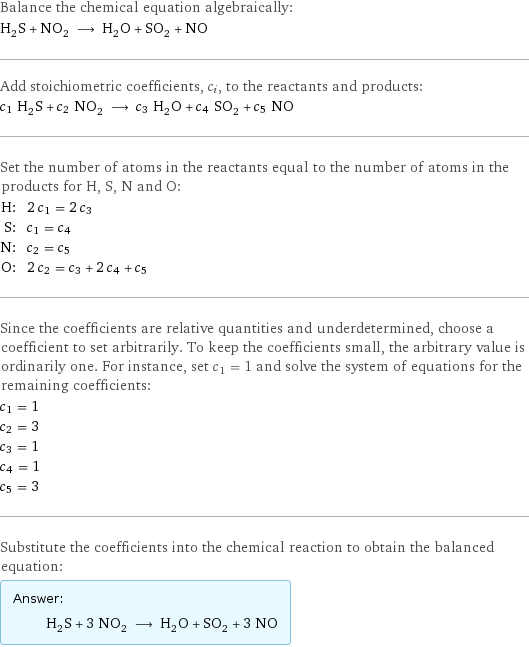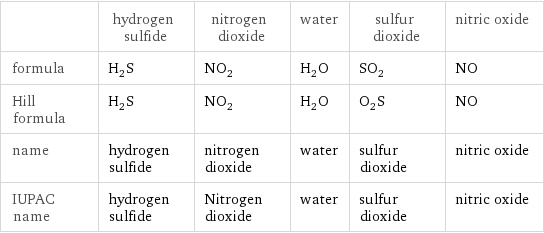Input interpretation

H_2S hydrogen sulfide + NO_2 nitrogen dioxide ⟶ H_2O water + SO_2 sulfur dioxide + NO nitric oxide
Balanced equation

Balance the chemical equation algebraically: H_2S + NO_2 ⟶ H_2O + SO_2 + NO Add stoichiometric coefficients, c_i, to the reactants and products: c_1 H_2S + c_2 NO_2 ⟶ c_3 H_2O + c_4 SO_2 + c_5 NO Set the number of atoms in the reactants equal to the number of atoms in the products for H, S, N and O: H: | 2 c_1 = 2 c_3 S: | c_1 = c_4 N: | c_2 = c_5 O: | 2 c_2 = c_3 + 2 c_4 + c_5 Since the coefficients are relative quantities and underdetermined, choose a coefficient to set arbitrarily. To keep the coefficients small, the arbitrary value is ordinarily one. For instance, set c_1 = 1 and solve the system of equations for the remaining coefficients: c_1 = 1 c_2 = 3 c_3 = 1 c_4 = 1 c_5 = 3 Substitute the coefficients into the chemical reaction to obtain the balanced equation: Answer: | | H_2S + 3 NO_2 ⟶ H_2O + SO_2 + 3 NO
Structures

+ ⟶ + +
Names

hydrogen sulfide + nitrogen dioxide ⟶ water + sulfur dioxide + nitric oxide
Reaction thermodynamics
Enthalpy

ΔH_rxn^0 | -308.7 kJ/mol - 79 kJ/mol = -387.7 kJ/mol (exothermic)
Gibbs free energy

ΔG_rxn^0 | -274.4 kJ/mol - 120.5 kJ/mol = -394.9 kJ/mol (exergonic)
Entropy

ΔS_rxn^0 | 950.9 J/(mol K) - 926 J/(mol K) = 24.91 J/(mol K) (endoentropic)
Units

Equilibrium constant
![K_c = ([H2O] [SO2] [NO]^3)/([H2S] [NO2]^3)](../image_source/8742a95285be969ee07c8da2f80e2200.png)
K_c = ([H2O] [SO2] [NO]^3)/([H2S] [NO2]^3)
Rate of reaction
![rate = -(Δ[H2S])/(Δt) = -1/3 (Δ[NO2])/(Δt) = (Δ[H2O])/(Δt) = (Δ[SO2])/(Δt) = 1/3 (Δ[NO])/(Δt) (assuming constant volume and no accumulation of intermediates or side products)](../image_source/d73b0483d3748f3e98d57d6c2c0e0900.png)
rate = -(Δ[H2S])/(Δt) = -1/3 (Δ[NO2])/(Δt) = (Δ[H2O])/(Δt) = (Δ[SO2])/(Δt) = 1/3 (Δ[NO])/(Δt) (assuming constant volume and no accumulation of intermediates or side products)
Chemical names and formulas

| hydrogen sulfide | nitrogen dioxide | water | sulfur dioxide | nitric oxide formula | H_2S | NO_2 | H_2O | SO_2 | NO Hill formula | H_2S | NO_2 | H_2O | O_2S | NO name | hydrogen sulfide | nitrogen dioxide | water | sulfur dioxide | nitric oxide IUPAC name | hydrogen sulfide | Nitrogen dioxide | water | sulfur dioxide | nitric oxide